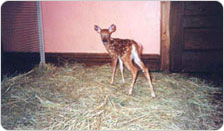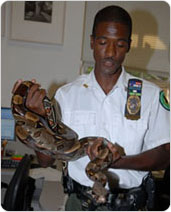Strange Park Visitors
Although the Parks Department's tens of thousands of acres of land are not without their share of wildlife, occasionally creatures creep through whose presence is too unordinary to go unnoticed.
Guinea Pigs in the Garden
It was the winter of 1998 when a Parks Department employee observed a man opening a cage, releasing small animals into Central Park's Conservatory Garden. It turns out the animals were South American guinea pigs, 43 in all, freed by a recently evicted owner unaware of other options for surrendering animals. Because the Parks employee had witnessed the release, quick action was taken, and nearly all of the guinea pigs were recovered within the course of a few days and put up for adoption, saving them from the fate of a snowstorm that followed, as well as the appetite of the park's hawks and owls.
Missing Mother Deer

Two years later in the summer of 2000, a visitor spotted a two-week–old abandoned fawn while riding through Forest Park on his bicycle. Other park patrons alerted the Queens Urban Park Rangers, who then captured the animal. After a veterinarian stabilized the orphan with a dewormer and fed it diluted goat milk, the fawn was moved to a certified rehabilitator.
The fawn's origin remains unknown, as well as how it came to the park. Forest Park is a self-contained park, and deer are not common to the area. Rangers believe the deer was probably picked up by an individual in an area outside the city and abandoned in the city. It is unlikely that the fawn made it to the park on its own, as it would have had to cross several major roads and highways, and young deer do not often wander far from their mothers.
The White–tailed deer was near extinction in the mid–20th century when its numbers were reduced greatly due to unrestricted hunting. Today, the populations of White-tailed deer have greatly increased thanks to game management measures throughout North America. Deer are occasionally spotted in Alley Pond Park in Queens and fairly often seen in Van Cortlandt Park and Staten Island parks, but until 2000, there had never been a sighting in Forest Park. Also in the summer of 2000, a deer swam ashore into Riverside Park but was hit by a car.
See You, Gator
The next summer, in June of 2001, a big toothed, scaly-skinned alligator seemed to be on the loose in Central Park. For one week, a gator–crazed city watched anxiously to see what would happen to the reptile in the park. The mayhem began Saturday, June 16, when an off duty police officer and his two children spotted the displaced creature in the Harlem Meer.
One week after the initial sighting, Mike and Tina Bailey, “alligator wrestlers” from Florida, traveled to New York to rescue the reptile. On the night of Thursday, June 21 at 9:20 p.m., the couple began their search. Reporters, cameramen, and Parks employees held their breaths. Within the hour, Mike Bailey had spotted the speckled caiman offshore. Effortlessly, Tina lifted the two foot creature out of the water and handed him to Mike, who properly identified it as a caiman, a species of crocodile unheard of in Central Park, but common to Central and South American wetlands. Then–commissioner Henry J. Stern did his part, naming the animal formerly known as an alligator, “Damon the Caiman.”
The caiman was transported to the Central Park Zoo where it was evaluated and taken into custody by the Wildlife Conservation Society.
Catch a Tiger by the Tail
Parkgoers picnicking in Forest Park got a scare in the summer of 2004 when a white Bengal tiger briefly escaped from his keepers in the Cole Brothers Circus, performing in the park that afternoon. After running through the park, Apollo the tiger took to the Jackie Robinson Parkway, for perhaps what he thought would be a speedier escape, instead causing minor traffic accidents before pausing to rest on a Queens street and being coaxed back into his cage by his trainer.
Just Slithering Through
On September 6, 2007, a visitor to Central Park was surprised to spot a Columbian red-tail boa snake peeking out from behind a pile of rocks. Once alerted, the police and Urban Park Rangers together lured the snack out of the rocks, where the apparently abandoned six-foot reptile was stuck. The snake, soon named Rocky Bal-boa, was transported to a reptile refuge shortly after his rescue.
As specified in the Health Code of the City of New York: Animals (24 RCNY Health Code ? 161.01), it is illegal to keep members of the Boidae family as pets in New York City, and therefore Rocky Bal-Boa, if indeed kept as a pet, was an illegal one at that.
A Masked Intruder
It was a warm, humid evening on September 25, 2007 when Rascal the Raccoon decided to escape the outdoors and take up residence in the Arsenal building, the main headquarters for Parks & Recreation. Room 309 was particularly to his liking, especially the spot on top of the room's air conditioner. On the morning of September 26, the room's four occupants found that they had a fifth officemate. Rascal was thus named by Commissioner Adrian Benepe after the classic children?s book of the same name by Sterling North. Rascal the Raccoon was mischievous, made a significant mess, and put up quite a fight before finally being corralled by members of the Urban Park Rangers.
Alternatives for Animals
Similar stories abound at Parks. From Rocky Balboa (a snake) in Central Park to tales of a bear on the loose (what turned out to be a Newfoundland dog) in Van Cortlandt Park to Zelda the turkey in Battery Park, and coyotes throughout the boroughs, New Yorkers have learned that confused tourists aren't always of the human lot.
Two important things to remember are:
- 1. Parks are not suitable homes for domesticated animals. If you see a tame, abandoned pet, alert an Urban Park Ranger or bring the animal to Animal Care & Control.
- 2. If you see an injured animal, the best thing to do is leave the animal where it is and locate an Urban Park Ranger in the park. Tell the ranger what kind of animal it is (e.g. bird, dog, raccoon), the size and color of the animal, and its observed condition (is it dead, acting disoriented, bleeding, or just walking around?). The more information you can provide, the better.
Please remember that young animals often look as if they have been abandoned, when in fact their parents are nearby. You are encouraged to leave the animal, even a cute baby, where it is, and tell a ranger. Most animals that are suspected of being sick or abandoned are fine and will be left where they are after a ranger checks it out.
Related Links
Animal Care & Control of New York City
NYC Department of Health and Mental Hygiene Veterinary and Pest Pages
Wildlife in Parks
Urban Park Rangers
Birding in Parks
Zoos and Aquariums in Parks
